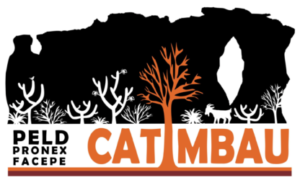1. Silva et al 2022a Higher flower number in Jatropha mutabilis (Euphorbiaceae) increases the frequency of floral visitors in the Caatinga dry forest. Arthropod-Plant Interactions
2. Silva et al 2022b Climate change will likely threaten areas of suitable habitats for the most relevant medicinal plants native to the Caatinga dry forest. Ethnobiology and Conservation
3. Oliveira et al 2022 Aridity mediates the effect of wood extraction on the reproductive output of an endemic disturbance-adapted woody species (Cenostigma microphyllum, Leguminosae) in the Caatinga dry forest. Austral Ecology
4. Centeno-Alvarado et al 2022a Climate change may reduce suitable habitats for Tacinga palmadora (Cactaceae) in the Caatinga dry forest: species distribution modeling considering plant‑pollinator interactions. Regional Environmental Change
5. Centeno-Alvarado et al 2022b Increasing chronic anthropogenic disturbances and aridity in differentially impact pollen traits and female reproductive success of Tacinga palmadora (Cactaceae) in a Caatinga dry forest. Regional Environmental Change
6. Barral et al 2022 Scented at day and night: diel variation in the floral scent chemistry of the threatened tree Amburana cearensis (Leguminosae) and effects of this variation on its pollinators. Flora
7. Lins et al 2022 Exotic goats do not affect the seed bank but reduce seedling survival in a human-modified landscape of Caatinga dry forest. Journal of Arid Environments
8. Oliveira et al 2022 Morphology of four common and phylogenetically distant ant species varies along disturbance and aridity gradients in the Caatinga dry forest. Biotropica
9. Câmara et al 2022 Drought-induced reductions in plant defenses: Insights from extrafloral nectaries in the Caatinga dry forest. Biotropica
10. Melo et al 2022 Aridity and chronic anthropogenic disturbance as organizing forces of fruit-feeding butterfly assemblages in a Caatinga dry forest. Biotropica.
11. Oitaven et al 2022 Trophic ecology of Gymnodactylus geckoides Spix, 1825 (Squamata, Phyllodactylidae) from Caatinga, Northeastern Brazil. Herpetozoa.
13. Pontes et al 2022 Staminode of Jacaranda rugosa A.H. Gentry (Bignoniaceae) promotes functional specialization by ensuring signaling and mechanical fito medium‑sized bees. Organisms Diversity & Evolution
14. Pinho et al 2022 Cross-scale drivers of woody plant species commonness and rarity in the Brazilian drylands. Diversity and Distributions
15. Oliveira et al 2022 Chronic anthropogenic disturbances and aridity negatively affect specialized reproductive traits and strategies of edible fruit plant assemblages in a Caatinga dry forest. Forest Ecology and Management
16. Santos-Neto et al 2022 Aridity, but not disturbance, reduces the specialization and modularity of plant–insect herbivore interaction networks in Caatinga dry forest. Journal of Insect Conservation
17. Souza et al 2022 Extrafloral nectar secretion does not mediate ant predatory activity on Pityrocarpa moniliformis plants in a seasonally dry forest. Acta Oecologia
18. Pimentel et al 2022 Estimates of insect consumption and guano input in bat caves in Brazil. Mammal Research
19. Bezerra et al 2022 Drastic impoverishment of the soil seed bank in a tropical dry forest exposed to slash-and-burn agriculture. Forest Ecology and Management
20. Vanderlei et al 2022 Impoverished woody seedling assemblages and the regeneration of Caatinga dry forest in a human-modified landscape.Biotropica
21. Merano et al 2022 Contrasting effects of chronic anthropogenic disturbance on activity and species richness of insectivorous bats in neotropical dry forest. Frontiers in Ecology and Evolution
22. Vieira et al 2022 Divergent herb communities in drier and chronically disturbed areas of the Brazilian CaatingaPerspectives in Ecology and Conservation
- Melo et al. 2023 – Aridity and chronic anthropogenic disturbance as organizing forces of fruit-feeding butterfly assemblages in a Caatinga dry forest
- Melo et al., 2023 – Resilient fruit‐feeding butterfly assemblages across a Caatinga dry forest chronosequence submitted to chronic anthropogenic disturbance

